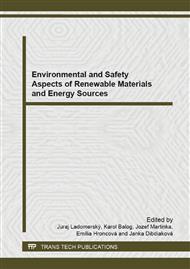[1]
M. Růžička: Timber buildings in the Czech Republic – current situation and solutions. Timber buildings. Volyně (2006), ISBN 80-86837-03-3.
Google Scholar
[2]
Information system of statistics and reporting: Indicators of the National Environmental Policy of the Czech Republic 2004 – 2010. Forest area as percentage of total land area of the country. Ministry of the Environment of the Czech Republic, CENIA (2010).
Google Scholar
[3]
P. Kučera, A. Lokaj, D. Kačíková: Assessment of reliability of timber structures elements exposed large-scale fire test. (2012) Acta Facultatis Xylologiae, 54 (1), pp.95-104.
Google Scholar
[4]
P. Kučera, A. Lokaj, V. Vlček: Behaviour of the spruce and birch wood from the fire safety point of view. (2013) Advanced Materials Research, Volume 842, pp.725-728. doi: 10. 4028/www. scientific. net/AMR. 842. 725.
DOI: 10.4028/www.scientific.net/amr.842.725
Google Scholar
[5]
M. Netopilová: Current Risks of Asbestos Exposure in the Building Industry. Occupational Safety and Health 2010. VŠB-Technical University of Ostrava (2010), ISBN 978-80-248-2207-5, p.180 – 189.
Google Scholar
[6]
A. Benešová, J. Vaněrek: The development of wood-plastic composites with an admixture of waste and secondary raw materials. Ekology and new building materials and products. Research Institute of Building Materials, Telč (2011).
Google Scholar
[7]
ISO 4589-2: 1996 Plastics - Determination of burning behaviour by oxygen index - Part 2: Ambient-temperature test.
Google Scholar
[8]
ČSN 64 0149 Determination of ignitability of materials. Czech technical standard.
Google Scholar
[9]
ISO 871: 2006 Plastics - Determination of ignition temperature using a hot-air furnace.
Google Scholar


